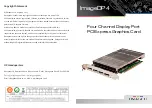
Chapter 4: Address Selection
The card uses four separate address spaces. COM A occupies 16 consecutive register locations and
COM B, COM C, and COM D each occupy eight consecutive register locations.
PCI architecture is Plug-and-Play. This means that the BIOS or Operating System determines the
resources assigned to PCI cards rather than you selecting those resources with switches or jumpers.
As a result, you cannot set or change the card's base address. You can only determine what the
system has assigned.
To determine the base address that has been assigned, run the PCIFind.EXE utility program provided.
This utility will display a list of all of the cards detected on the PCI bus, the addresses assigned to each
function on each of the cards, and the respective IRQs (if any) allotted.
Alternatively, some operating systems (Windows 95/98/2000) can be queried to determine which
resources were assigned. In these operating systems, you can use either PCIFind (DOS), PCINT
(Windows95/98/NT), or the Device Manager utility from the System Properties Applet of the control
panel. The card is installed in the Data Acquisition class of the Device Manager list. Selecting the card,
clicking Properties, and then selecting the Resources Tab will display a list of the resources allocated to
the card.
PCIFind uses the Vendor ID and Device ID to search for your card, then reads the base address and
IRQ.
If you want to determine the base address and IRQ yourself, use the following information.
The Vendor ID for the card is 494F. (ASCII for "IO")
The Device ID for the card is 1059h.










































